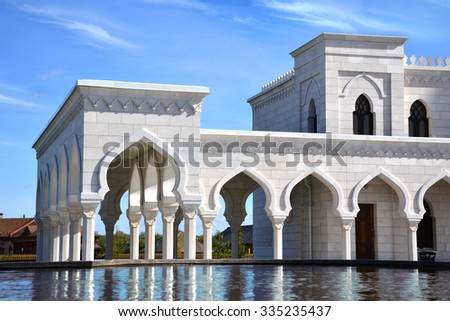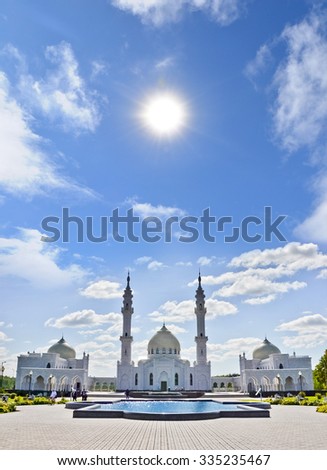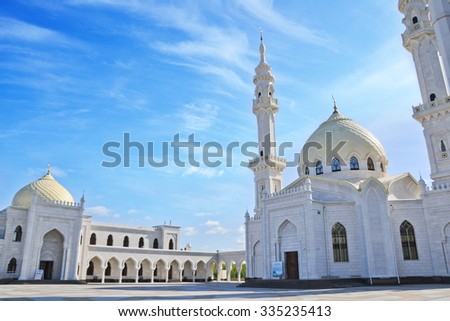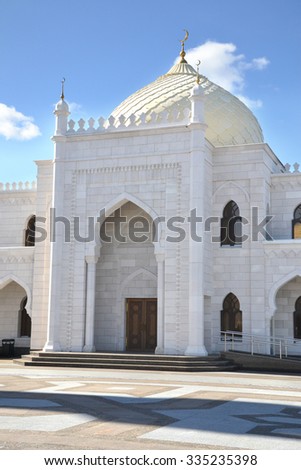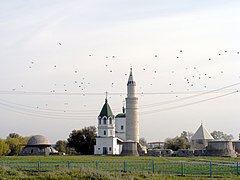Bolgar, Spassky District, Republic of Tatarstan
Bolgar (Russian Болгар; Tatar Болгар / Bolgar ) or Veliky Bolgar, unofficially also called Bulgar, Bolgari or Bolgary, is a city in Russia, on the banks of the Volga River in the Republic of Tatarstan. In the 8th to 15th centuries it was the capital and center of the Volga Bulgars ( Proto-Bulgarians ). Today it is a small town with 8650 inhabitants ( October 14, 2010 ) and the administrative center of Rajons Spassk.
History
The city was founded by the Volga Bulgars under Khan Kotrag as their capital in the 8th century. They were joined by Finnish and Slavic populations. At the time of Ibn Fadlan Arab travelers, who took part in an embassy to the Volga Bolgar 922 by the Bulgarians, the city had about 10,000 inhabitants with about 500 houses. Shortly after his visit to the city but had been invaded by 968/969 by the Russians, which the trade of the city was inflicted a painful injury. Especially from Arab sources, the contemporary reports of trafficking in Bolgar. Bolgar was expanded with Arab money bonds become an important commercial center. We traded furs, slaves, honey, animal skins which were used as carpets use, amber, walrus teeth, wax and cereals. They show the close links of the Kingdom of the Volga Bulgarians with Central Asia. Even Russian traders came to action after Bolgar. Despite the trade with Arabia nevertheless remained at the Slavic and Bulgarian populations the old Turkish traditions and customs of the Tengriasm. So flourished through the Arabic Bulgarian amalgamation in Bolgar science and culture. At the beginning of the 11th century the town was a wall of oak.
The archaeological legacy on the castle wall in Bolgar will accept 10-12. Century recognize a castle town with far-reaching long-distance trade links between East and West as well as branches of foreign merchants ( from Armenia, the Rus and Danube Bulgaria). Found here silver and copper coins bear partly Arabic, partly Kufic script and are characterized beautiful part. Furthermore, many grave stones with Tatar, Arabic and Armenian inscriptions and sculptures, as well as ancient weapons, coins and utensils of all kinds have been preserved.
Already on the orders of Peter the Great the grave inscriptions were 49 recorded and tried to explain. The Arab originate from the period 619-742 AH; among the Armenian is one of 557 and two of 984 and 986 AD
Between 1361 and 1367 the city was destroyed by the Golden Horde of Mongols under Timur Khan Bolod. While Russian invasions in the 14th century, the capital had been transferred to Bilar; after its looting and destruction she was transferred back again to the 15th century after Bolgar. As the Khanate of Kazan founded, was elected as the new capital Kazan. At this time Bolgar was a religious center of Islam.
In the 15th century the city was destroyed again by the Russian Prince Vasili. 1552 the city such as the Khanate of Kazan by the Russian Tsardom was annexed under Ivan the Terrible.
After the takeover by Russia to impoverished Bolgar Russian peasants were settled in the area, which used as a building material, the remains of the once mighty city. For this reason Tsar Peter the Great issued a special decree to preserve the Bolgarer ruins, which historically represents the first Russian law for the protection of a city with a historical background.
1781, the city under the name Spassk (Russian Спасск of Спас for, Saviour ') the administrative seat of a Ujesds was. Between 1926 and 1935 the city was called Spassk- Tatarski ( Спасск - Татарский ), to distinguish it from other cities of the same name, as Spassk- Rjasanski or Spassk- Dalni can. From 1935 to 1991, it bore the name of the revolutionary Kuibyshev ( Куйбышев ) - as well as in Siberia and the Kuibyshev also located on the Volga Samara today. In 1991, one of the city its old name back Bolgar.
Demographics
Note: Census data
Attractions
Today's Bolgar is within the still largely preserved ramparts lines of the old Volga Bulgarians Capital Bolgar, of which still towers ( the best preserved of the so-called Misgir Tower ) and remnants of walls remain.

